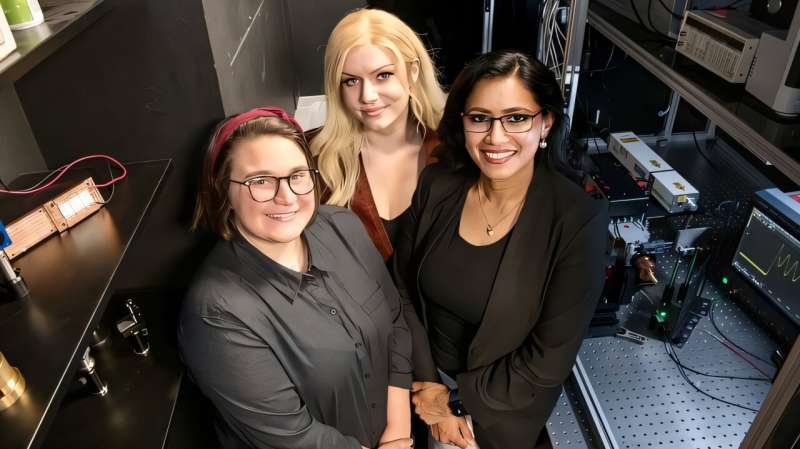With the ability to detect and amplify extremely weak electromagnetic signals without adding additional noise, masers have many potential uses, including the production of more sensitive magnetic resonance body scanners, such as those used in airports.
Despite their discovery in the 1950s, there has been little development of the technology since then due to the complex and expensive conditions required to make them—masers are only able to be produced in very cold conditions, while also within a vacuum and a high magnetic field.
Northumbria’s Dr. Juna Sathian is one of the U.K.’s leading experts in maser technology and has previously worked with colleagues at Imperial College London and University College London to develop a room-temperature maser which works using laser light. However, this method is expensive and difficult to replicate in everyday applications.
Dr. Sathian has led an all-women team of researchers to explore the use of LEDs to create an affordable, energy-efficient alternative, which could be used in quantum technologies, deep-space communications, and portable sensing devices.
A paper detailing their breakthrough, titled “LED-pumped room-temperature solid-state maser,” has now been published in Communications Engineering.
Carrying out the research alongside Dr. Sathian is Dr. Bethan Ford—a Senior Technician within Northumbria’s Faculty of Energy and Environment, and the first researcher to join the project at Northumbria. Her foundational postdoctoral work was critical to establishing the maser platform.
Final-year Ph.D. student Sophia Long is the first author of the paper, with her meticulous and sustained experimental efforts integral to achieving the LED-pumped maser’s successful operation.

Dr. Sathian is committed to encouraging more young people, especially young women, into STEM subjects, and is a committee member of the Institute of Physics’ Women in Physics Group, as well as Head of Physics at Northumbria.
Speaking about the research, she said, “This pioneering work represents a significant advancement towards affordable, energy-efficient maser technology and highlights the exceptional contributions of our team of women scientists leading this research.
“By replacing complex laser systems with low-cost LEDs, we have opened the door to practical masers that can operate at room temperature, unlocking exciting potential in quantum technologies, secure communications, deep-space exploration, and portable sensing.
“Realizing this breakthrough required persistence, creativity, and precision across many disciplines, from materials design to photonic engineering, and I’m incredibly proud of the collaborative spirit and scientific rigor our team has shown. Having the right people, with the right mix of skills and a shared vision, was absolutely critical to achieving what has eluded the field for decades.
“This is just the beginning. The future of maser research lies in developing compact, scalable systems that can be integrated into next-generation quantum and photonic platforms. We are now working to extend this technology into new materials, broader frequency ranges, and real-world applications, bringing masers from lab curiosity to everyday utility.”
The Northumbria research team worked in close partnership with leading international collaborators, including Dr. Lisa Lopez and Professor François Balembois, of the Institut d’Optique Graduate School, Université Paris-Saclay, France; Dr. Riccardo Montis, of the University of Urbino, Italy; Dr. Daan Arroo, Dr. Wern Ng and Professor Neil Alford, of Imperial College London; and Northumbria’s Dr. Hamdi Torun.
Professor Alford said, “I’m delighted to see this work published—it’s the result of a really productive collaboration between Imperial and Northumbria and I look forward to the next challenge for the team.”
Professor Balembois added, “LED-pumped luminescent concentrators promise a bright future as new sources combining power and brightness. We are proud to contribute to the emergence of LED-pumped MASER.”
More information:
Sophia Long, LED-pumped room-temperature solid-state maser, Communications Engineering (2025). DOI: 10.1038/s44172-025-00455-w. www.nature.com/articles/s44172-025-00455-w
Citation:
Affordable, room-temperature maser created using LED technology (2025, July 9)
retrieved 10 July 2025
from
This document is subject to copyright. Apart from any fair dealing for the purpose of private study or research, no
part may be reproduced without the written permission. The content is provided for information purposes only.

